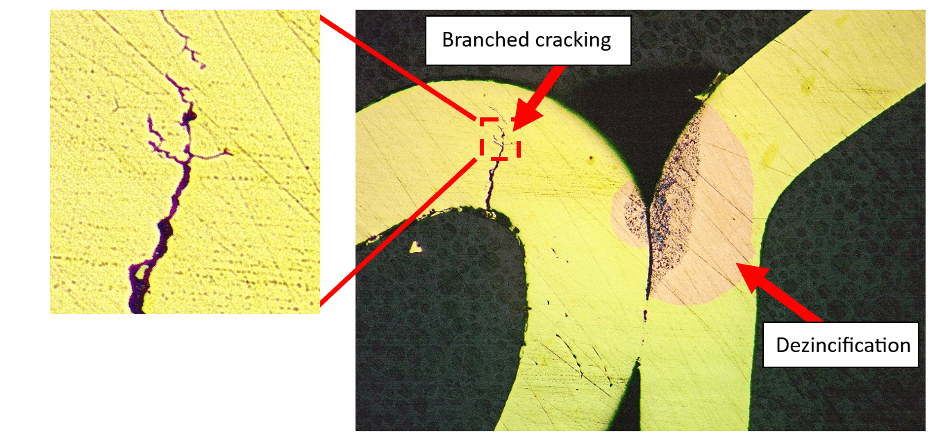By Nicolas Cunningham, Ph.D., P.Eng.
Brass alloys are widely used to produce plumbing components, and typically perform well for years in most applications. It is not uncommon for potable water plumbing systems inside a residence to contain many brass fittings that are generally forgotten and unproblematic. From time to time, leaks are associated with brass plumbing components even if they were sourced from domestic suppliers with good reputations for durability and quality. This article presents a brief overview of brass alloys and the major failure mechanisms observed when components made from commercial brass alloys leak.
Copper can be alloyed with a variety of metals, but in brass zinc is the most common. The level of zinc in brass alloys is visually observed when the zinc concentration reaches approximately 20% at which point the brass exhibits a yellowish tint (yellow brass) compared to the reddish color associated with lower zinc content red-brass alloys and pure copper. Figure 1 presents the tint (color) of different brass alloys in comparison with a piece of copper tubing.
 Figure 1 – Brass alloy colors in comparison with piece of copper tubing
Figure 1 – Brass alloy colors in comparison with piece of copper tubing
The two main failure mechanisms of brass components
In general, two main failure mechanisms are observed in the field when brass alloys are exposed to domestic potable water: dezincification and stress corrosion cracking (SCC). Dezincification is associated with a gradual removal of the zinc from the alloy which results in a thinned, porous, and weaker part (Figure 2).

Figure 2 – Dezincification
SCC is a term used to describe service failures caused by slow, environmentally induced crack propagation. SCC occurs when three conditions are present: 1) a material is susceptible to a specific corrosive environment (for yellow brass, ammonia or nitrogen bearing organic compounds); 2) the material has extended exposure to that corrosive environment; and 3) the component is in a state of mechanical stress. SCC is typically associated with minimal ductile deformation on and around the fracture surface, which also can also exhibit a grainy sand-like appearance (Figure 3).

Figure 3 – Stress corrosion cracking (SCC)
In most large Canadian municipalities, a significant proportion of leaks occurs in residences not supplied by municipal water systems or where a specific water chemistry occurs. For example: homes supplied through surface or drilled wells or drawing untreated water from nearby bodies of water. Nearly all brass plumbing components are sensitive to SCC (especially those made from yellow brass), however NPT (National Pipe Thread (Tapered)) female fittings, ball valves, and threaded components are typically the most likely to fracture and leak due to SCC. While the exact sensitivity of various brass alloys to SCC is the subject of some debate, it is generally accepted that yellow brass alloys containing more than 15% or 20% zinc are much more sensitive to SCC than red brass alloys with a lower zinc content.
When factors are combined and cause the demise of brass components
The stress applied to brass fitting components is the sum of residual stress from production, the stress due to the water pressure and the stress arising from assembly or installation. SCC related leaks in brass plumbing components are generally the result of substandard manufacturing such as aggressive machining operations, improper heat treatment, or errors during final assembly by the manufacturer. The choice, by the component designer or the manufacturer, of a brass alloy containing high levels of zinc can also be a contributing factor.
The presence of a reddish tint on a fracture surface should not necessarily be taken as a telltale sign that dezincification is the main failure mechanism. In certain cases, cracking related to SCC has already penetrated through the component walls while dezincification at several locations is ongoing (Figure 4). A complete metallographic analysis can identify the primary failure mechanism which may or may not be related to dezincification.

Figure 4 – SCC and dezincification observed on the same plumbing component.
Materials and metallurgical experts at CEP Forensic can provide expert services, conduct metallurgical examination of brass pluming component, and identify root cause of leaks to support claims management as well as supporting subrogation efforts.
